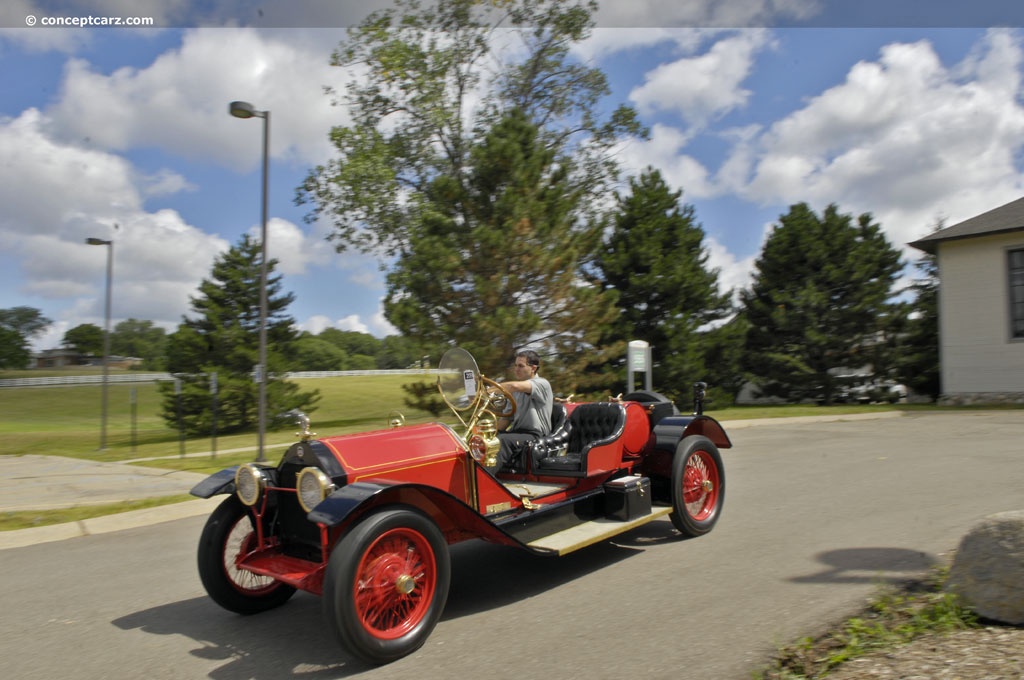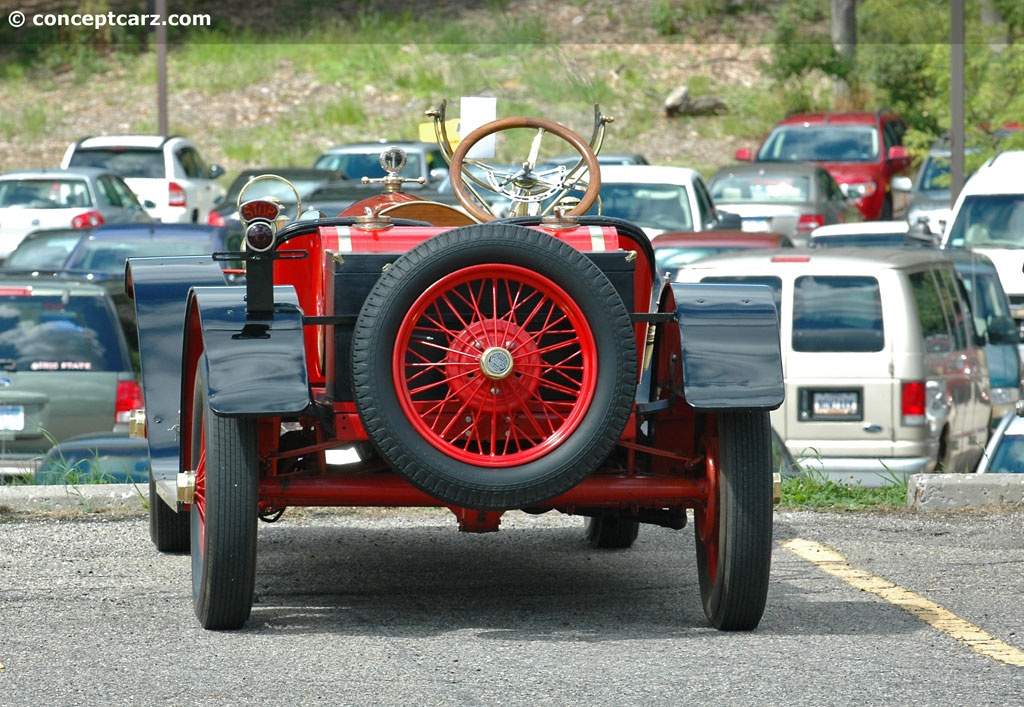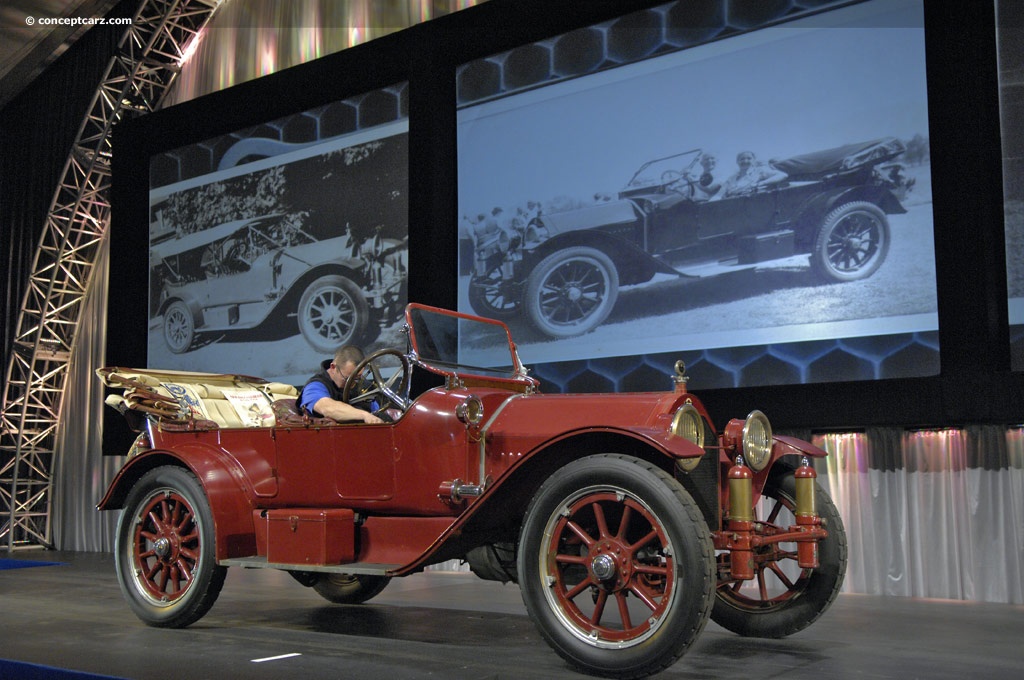1915 Stutz Model 4F Navigation
Indianapolis, Indiana-based Stutz Motor Car Company of America built a car in under five weeks and entered the inaugural Indianapolis 500 in 1911, driven by Gil Anderson to an 11th place finish, it earned the slogan 'the car that made good in a day.' The Stutz was built by Harry C. Stutz and his friend Henry F. Campbell, and although 11th place did not earn any prize money, it did help cement the company's future. The car had averaged 62.375 mph, and its 389 cubic-inch engine had been much smaller than the rest of the field. Some argue that if the car did not require pit stops for tire changes (13 pit stops, 11 of which being for tires), it would have finished even higher. 
Bearcat
Chassis #: 2476
View info and history
Auction entries : 1Harry Stutz had been in Indianapolis since the early 1900s and his talents were employed by several companies over the years. Among his early accolades include designing a rear-axle mounted transmission, and by 1910 he had established his own firm, the Stutz Auto Parts Company, for its manufacture. In June of 1911, Harry and Henry organized the Ideal Motor Car Company. The name was changed in June of 1913 to the Stutz Motor Car Company and the Stutz Auto Parts Company was merged into it. The early cars were powered by a T-head, 389 cubic-inch, 60 horsepower Wisconsin brawny four-cylinder engine with four valves per cylinder. One of the earliest multi-valve engines, it was paired with one of Harry Stutz's transaxles - this technology was advanced (perhaps five decades ahead of its time). In 1917, Stutz began to manufacture its own powerplants. The production version of that car was the Model A Bearcat of 1912. It rested on a 118-inch wheelbase platform and was devoid of non-essential items. The lightweight vehicle, with minimal bodywork, was comprised of seats and tanks. Other body styles in the 1912 lineup included a roadster, toy tonneau, 5-passenger tourer, and a coupe. A larger Model A was available, with wheelbase sizes that ranged from 124- to 130 inches. These were powered by a six-cylinder engine offering 70 horsepower. A Bearcat body style was also included in the 6-cylinder Model A lineup. 
Bearcat
Chassis #: 2476
View info and history
Auction entries : 1In 1912, Stutz entered 30 different racing contests and won 25 of them, often using a stock Bearcat. By 1915, the Stutz company had built a specially prepared race car powered by Wisconsin-built single overhead cam 16-valve engines. Known as the 'White Squadron' they were the chief rival to the Mercer Company. Also in 1915, Cannon Ball Baker drove a four-cylinder Bearcat from San Diego to New York in 11 days, 7 hours, 15 minutes. This was a new transcontinental record. The 1915 Stutz lineup included the Series H.C.S. and the Series 4F. The H.C.S. was a lower-priced alternative offered as a roadster and powered by a 4-cylinder, 35 horsepower engine. The 108-inch wheelbase platform was shorter than the Series 4F, which measured 118 inches. Powering the Series 4F was a 50 horsepower, four-cylinder engine. Body styles included the roadster, bearcat, coupe, bulldog, sedan, and tourer. The Series 6F had nearly identical body styles to the 4F, with a 6-cylinder, 55 horsepower engine, and a 130-inch wheelbase. Stutz had built 266 vehicles in 1912 and by 1915 they had built over one-thousand vehicles in a single year for the first time, with 1,079 vehicles sold.
by Daniel Vaughan | Jan 2020

Bearcat
Chassis #: 2476
View info and history
Auction entries : 1

Bearcat
Chassis #: 2476
View info and history
Auction entries : 1
by Daniel Vaughan | Jan 2020
In 1876, Harry C. Stutz was born. He grew up on the family farm, where he often helped repair their farm equipment. This led to a fascination with engines, and in 1897, he built his first car; soon after he began designing and creating engines. The Stutz Company, based in Indianapolis, Indiana, introduced its first production vehicle in 1911. The vehicle, after only five months of design and build, was immediately entered in the inaugural Indianapolis 500-mile race where it captured an 11th-place finish. Not bad for its first vehicle and first race. Throughout the company's life span, it would endure good and bad times. The Stutz Company was in production during World War I and the Great Depression, both responsible for negatively affecting Industry.
Bearcat
Chassis #: 2476
View info and history
Auction entries : 1Stutz will be forever remembered for their Bearcat model, a vehicle produced until 1925. This pure-bred race car had an aggressive and masculine stance; the interior was void of luxury and amenities. With its high-revving straight 8-cylinder overhead camshaft engine and lightweight construction, the vehicle was poised to compete in national and international competition.In 1919, Harry Stutz was forced by stockholders to leave his company. In 1922, Charles Schwab was given control of the company. In 1925, Schwab gave control of the company to Frederick Moskovics. Moskovic planned to revitalize the company by shifting the priorities from racing to producing luxurious automobiles. This did not mean that the company was to abandon its racing heritage, rather, Moskovics wanted to expand its racing prowess by entering International competitions. The 24 Hours of Le Mans is a grueling endurance battle that tests stamina, speed, and durability. In 1928 a Stutz Series BB Black Hawk Speedster, driven by Edouard Brisson and Robert Bloch, was entered in the French LeMans race. The vehicle did well, leading for most of the race. Halfway through the 22nd hour, the gearbox broke on the Stutz, and a Bentley 4.5-liter was able to secure a first-place finish. The Stutz was second, the best an American car had ever placed in this prestigious race.In 1929, the Stutz Company decided to increase their chances of victory by entering more than one vehicle into the Le Mans race. The vehicles were designed and prepared especially for the race. Gordon Buehrig was tasked with designing the bodies for the 2-seater sportscars. A modified 5.5-liter straight 8-cylinder with a supercharger were placed in the front and powered the rear wheels. Three vehicles entered by Stutz Paris, Colonel Warwick Wright, and Charles Weymann were anxiously anticipating a repeat of the prior year's success or possibly an overall victory. Sadly, only one vehicle would finish. Behind a fleet of Bentleys was the Stutz, followed by a Chrysler 75. With a fifth-place finish, the Stutz cars were no match for the powerful and agile Bentley Speed Six models.
Bearcat
Chassis #: 2476
View info and history
Auction entries : 1In the early part of 1929, Moskovics resigned, and Edgar Gorrell assumed the duties of president. Many manufacturers were developing multi-cylinder cars, which attracted a larger market share of the already small luxury car market. The Stutz Company was not in a financial position to develop an engine of this caliber. Instead, Stutz embarked on developing an inline eight-cylinder engine with single overhead cams. The result was the SV16, representing the side-valve 16, meaning that one exhaust and one intake valve per cylinder was allocated for the eight cylinders. By using the name SV16, it gave the vehicle an allure of equal capacity to other nameplates such as the Cadillac and Marmon V16. The SV-16 came equipped with windshield safety glass and hydrostatic brakes. The chassis sat lower than most of the competition giving it an advantage through turns. During its production run, around 100 examples were produced.Following on the heels of the SV16 was the DV-32. The engine featured updraft Schebler carburetors and four valves per cylinder equaling 32 valves and dual overhead camshafts. The powerplant was capable of producing 156 horsepower. The vehicle sat atop a 145-inch wheelbase and was outfitted with Stutz 8 hubcaps. At $6,400, these vehicles were extremely expensive at the time. In 1929, the Blackhawk series was introduced. These sports cars were affordable, competitive, and compact, outfitted with a six-cylinder engine. 
Bearcat
Chassis #: 4F2658
Engine #: AI 1006
View info and history
Auction entries : 3The demise on the race track would slowly transcend to the marketplace. For all of 1930, there were less than 1500 cars produced. Sales declined even more in the following years, and in 1934, after only six Stutz cars were produced, the factory closed its doors. This is not to suggest the racing results were solely responsible for the company's woes. The Great Depression crippled and destroyed many auto manufacturers at this time. Competition in design and technology was ever present, and the dependable, mass-produced, low-cost automobile manufacturers were in the best positions to come out on top. The Stutz Company had an impressive racing heritage, and its automobiles are legendary. The Stutz name is respected by many, including those overseas.
by Daniel Vaughan | Jan 2020

Bearcat
Chassis #: 2476
View info and history
Auction entries : 1

Bearcat
Chassis #: 2476
View info and history
Auction entries : 1

Bearcat
Chassis #: 4F2658
Engine #: AI 1006
View info and history
Auction entries : 3
by Daniel Vaughan | Jan 2020
Related Reading : Stutz Bearcat History
The Stutz Bearcat was produced from 1914 through 1924. The first version was produced from 1914 to 1917 and was powered by a 6388 cc four-cylinder engine. The Bearcat was a creation inspired by an Indy sports car racer built by the Stutz Motor Company in 1911. It was powered by a 361 cubic-inch four-cylinder engine that produced 50 horsepower. The Bearcat continued the tradition of lightweight construction,....
Continue Reading >>
Continue Reading >>
- 1915 Stutz Model 4F Menu
- Article
- Image gallery
- Valuation
- Specifications
- Profiles
Stutz
Similar Automakers
Similarly Priced Vehicles
1915 Stutz Model 4F Vehicle Profiles
Recent Vehicle Additions
Performance and Specification Comparison
Price Comparison
Bearcat Specification Comparison by Year
Year
Production
Wheelbase
Engine
Prices
Related Automotive News

Fighting spirit: The history of Aston Martin in Grand Prix racing
Aston Martin is returning to the F1TM grid in 2021 for the first time in over 60 years
Better known for its achievements in sports car racing Aston Martin also has a fascinating Grand Prix history, rich with anecdotes and characters
Key figure...

An Elegant Lineup of Prewar Classics are Unveiled for Gooding & Company's 2020 Scottsdale Auctions
Highlights include a BMW 328 from single family ownership with storied history, the striking Hispano-Suiza J12, a beautifully restored Stutz Series M, and a Cord 812 SC Cabriolet with exceptional provenance
Santa Monica, Calif. (December...

Volkswagen Golf GTi TCR Opens For Order In The Uk
290 PS race-inspired special costs from £34,135 RRP OTR
Suite of extras marks car out from GTI Performance
5.6 seconds to 62 mph 164 mph top speed, where legal
Milton Keynes – The race car-inspired Volkswagen Golf GTI TCR is now open for...

Historic Bothwell Collection 100% Sold
Woodland Hills, Calif. – 12 November 2017 – Its the last of the kind – a self-contained 16-acre working citrus farm, ringed with towering palm trees, sprinkled with WWII-era ranch buildings, situated just over the hill from Los Angeles. Its...

Sportiness In The Brand DNA: Game-Changer With Mercedes-Benz At Goodwood Festival Of Speed 2017
With a dozen racing cars and sporty vehicles from over 100 years, Mercedes-Benz Classic sums up the motto of this years Goodwood Festival of Speed Peaks of Performance – Motorsports Game-Changers celebrates competition vehicles that have written...






































